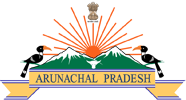About District
The land measuring approximately 3014Sq.Kms surrounded by unique picturesque hills in the western part of Arunachal Pradesh sharing international border with China. It lies between the latitudes 92º 36’ E to 93º 24’ E and the longitudes 26º 56’ E to 27º 59’ E.The District derived its name from the mighty River Kameng which originates from a high peak in Khenewa Circle. The river flows from the northwest to the southwest part of the district and then crossing over to West Kameng&PakkeKessang districts and finally reaches Assam in Bhalukpong Circle. It shares an international border with China and a district border with PakkeKessang and West Kameng Districts of Arunachal Pradesh.
BRIEF HISTROY OF EAST KAMENG
The East Kameng District was a part of Kameng District on 1st June June 1980, as per re-organization of District Act 1980; the eastern part of Kameng formed a separate District known as East Kameng with the Headquarter at Seppa. The name is derived from the Kameng River, a tributary of the Brahmaputra that flows through the district. Till , 1914, the District was a part of “NORTH EAST FRONTIER” tract and the British subjects were regulated by an “Inner Line” Pass system.
In 1919, this tract was re-named as “BALIPARA FRONTIER TRACT” having its headquarter at Charduar. In 1946, the area north of theBalipara Tract was name as “SELA SUB-AGENCY”. In 1954, this Sela Sub-Agency was again renamed as KAMENG FRONTIER DIVISION with headquarter later transferred to Bomdila.
1st September 1965, the Ministry of Home Affairs, took over the Administrative charge of North East Frontier Agency from Kameng Frontier Division and renamed as Kameng District. The political officer was re-designated as the Deputy commissioner on 1st June 1980 as per re-organasation of District. The Kameng was bifurcated in 2 (Two) district, i.e East Kameng and West Kameng.
TOPOGRAPHY AND RIVER SYSTEM:
The East Kameng district is a western part of western Himalayan range. The deep Gorges and narrow valley frequently open up wide valley which sustains permanent agricultural activities to the in habitant of the district.
The mighty river ‘KAMENG’ is originated from the Glacial lakes below ‘GORICHEN’ flow through this district to the plain of Assam to join the river Brahmaputra and other important rivers are PACHA, PACHI, PARA, PACHOK, PAKOTI, KAYA, PAKKE, BICHOM, PAPU, PASSA, NAMORA and DIKALMUKH. These rivers are full of turbulent and hence not navigable. However, rafting is conducted rarely.
CLIMATE:
The district is situated on hilly track ranging from 150 mtrs to 960 mtrs of elevation. For this reason, the climate condition has little varies in the district. Heavy rainfall occurs nearly 3 to 4 month. The average annual rainfall of the district is 998.2 mm in 2010-11 winters cover the month of November to February.
PHYSICAL FEATURES:
East Kameng District is situated in the western part of Arunachal Pradesh, which exactly lies to the East of West Kameng District. It is approximately lying between 920 36’ to 930 24’ East Longitude and 260 56’ North to 270 59` North latitude. The district is surrounded by Papum Pare District and some part of KurungKumey District of Arunachal Pradesh in the East, Sonitpur District of Assam is in the South. In the Westside of the District is West Kameng District. Mac Mohan line (International boundary) and a portion of KurungKumey District are in the North.
TOPOGRAPHY:
The Inter District baring as small area on the southern most thick which border Assam is mountainous the Deep gorges and narrow valleys frequently open into wise valleys which sustain permanent agriculture. The district is an extension part of North East towards Himalayan ranges.
RIVER SYSTEM:
The name “Kameng” has derived from the Kameng river, a tributary of the mighty Bramahputra and the Kameng river originating in the glacial lakes below “Gorichan” Flows through this District to the plain of Assam, where it is joint the Brahmaputra in the Sonitpur District of Assam. There are other important rivers also, which are called PACHA, PACHI, PACHUK, PAPU-PARA, PAKKE (I), PAKKE (II) BISHOM and DIBRU. These rivers tributary of Kameng are not navigable.
CLIMATE AND RAINFALL:
Due to its varieties Topography, differences the climate condition of this District vary largely within short distances. The altitude of different administrative centres varies ranging from 363 Mtrs to 1906 Mtrs. The district experiences rainfall especially in summer season, and winter months are extremely cold.
As a result of heavy rainfall during the monsoon season, most rivers and streams are highly inflated and disrupted normal transport system and communication and the landslide which make quite costly in the maintenance of roads many developmental activities are held up during the monsoons. The months from October to March, are the most favourable time to intensify work for development.
INHABITANT:
The Principal Tribes inhabiting inthis District are NISHING, AKA, MIZI and PUROIK (SULLONG). The Nyishi constitute the major tribe and scatter throughout the District. The Puroik(Sullong) are inhabited mostly in Chayangtajo, Khenewa, Sawa,Lada, Pipu&Gyawepurang Circles.
POPULATION:
According to 2001 Census the decennial growth rate of this district is 13.46 with the total Population of 57,179. The density of Population is 14 per sq kms. The literate rate of this district is 40.6% and sex ratio is 985 per thousand males.
POLITICAL SET UP:
The process of democratic decentralization began in this district in the year 1976, with introduction of Panchayat Raj Organisation Act 1967. Under this regulation the Gram Panchayat exists at the village level. The AnchalSamities covered in the Block level and Zilla Parishad covered all districts with a view to develop socio economic condition of this district as a whole.
The district has a segment of 1-Arunachal west Parliamentary constituency and 5(five) Assembly constituencies viz. 8-Bameng Assembly constituency, 9-Chayangtajo Assembly constituency, 10-East Seppa Assembly constituency, 11-west Seppa and 12-Pakke-Kessang Assembly constituency.

